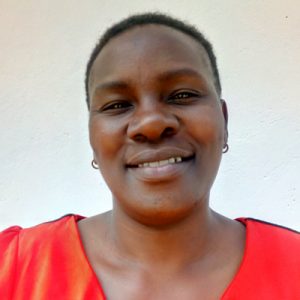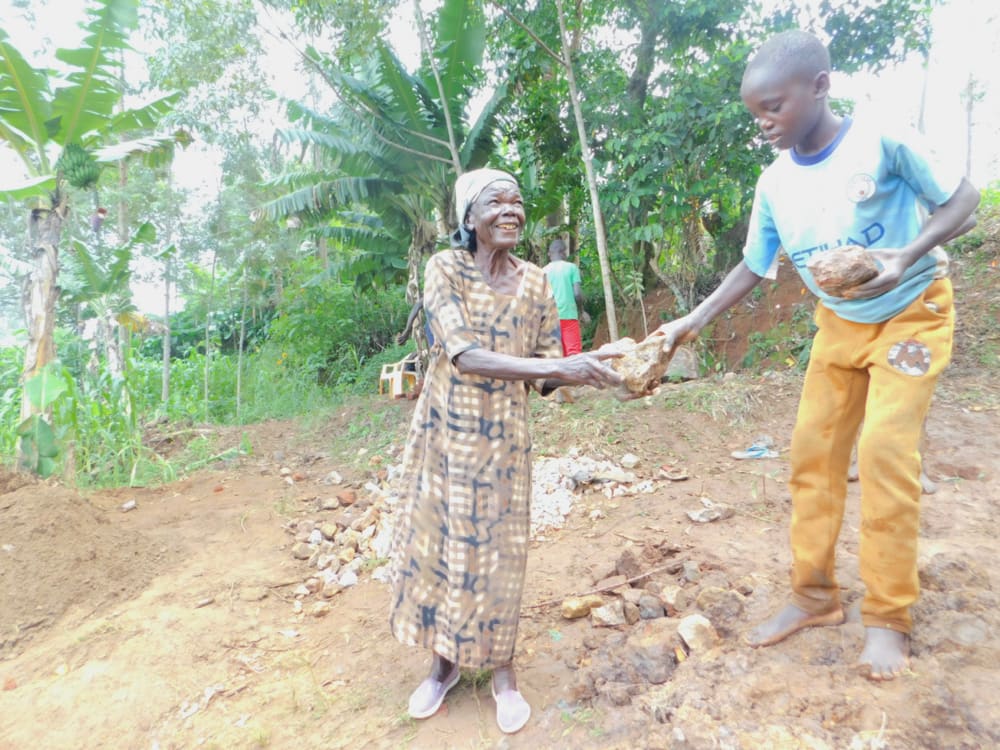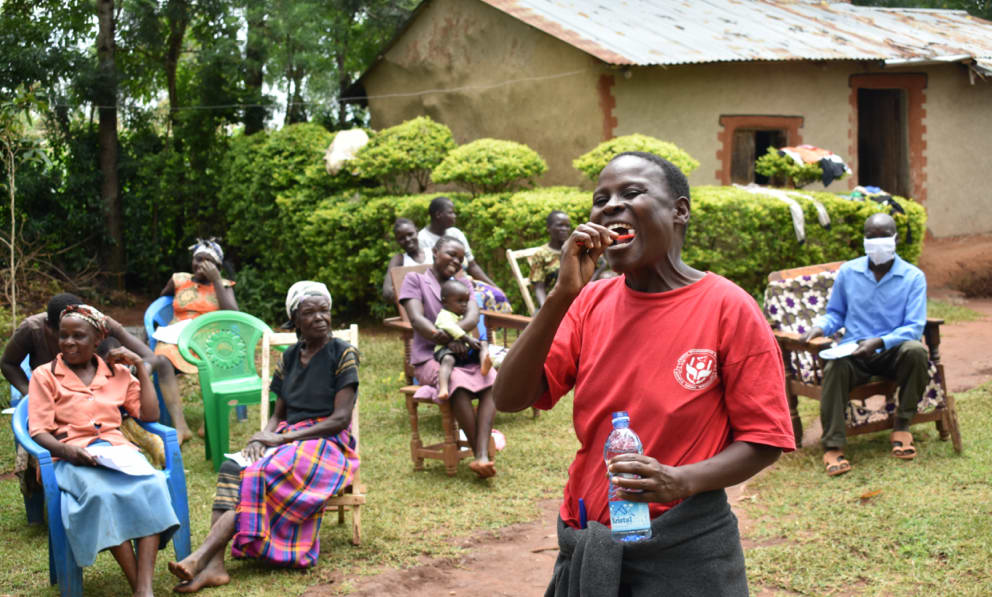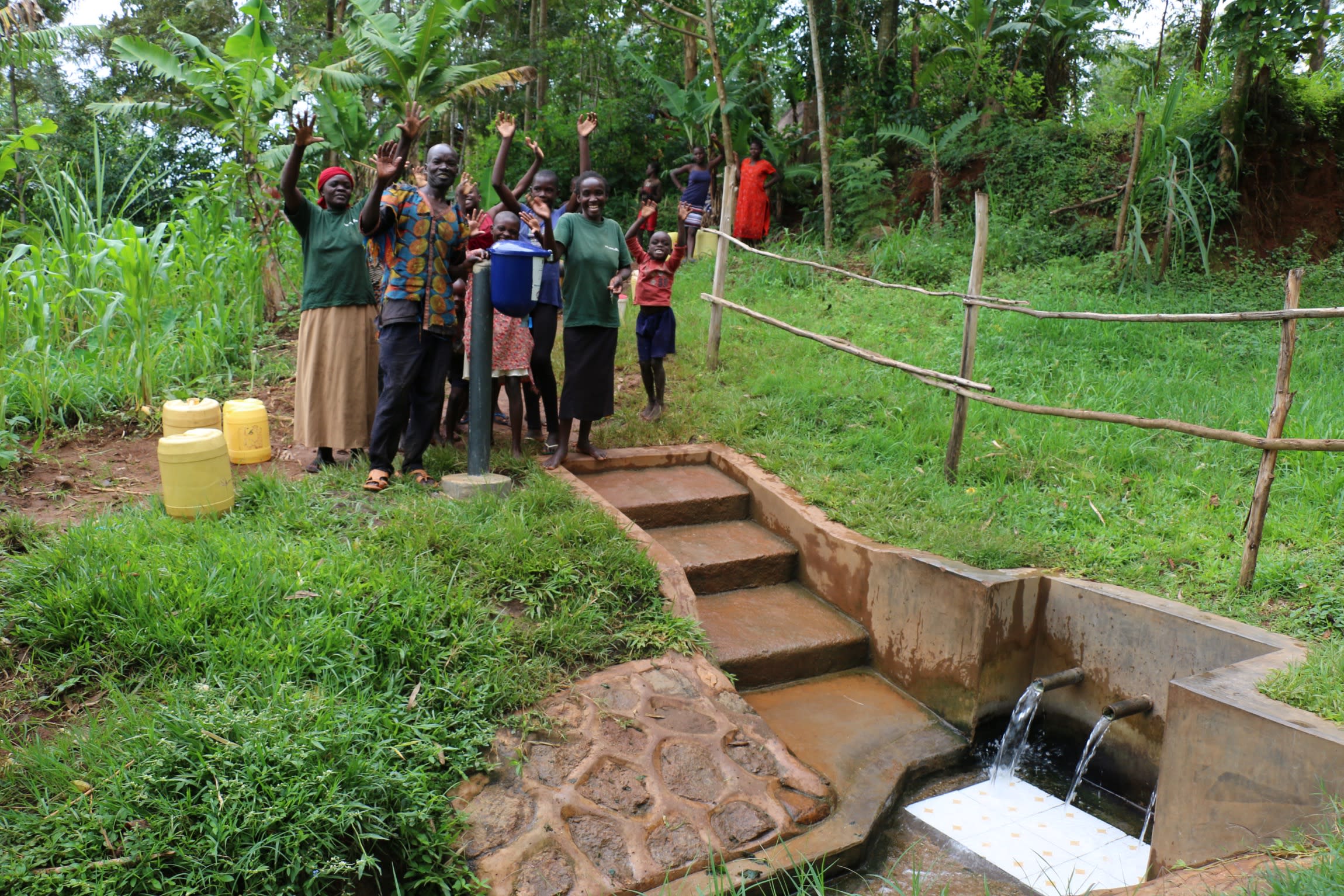Please note: original photos predate the COVID-19 pandemic.
Shemema Spring is located in Mukhweso Community. Most members of this community are farmers, and since (at the time of writing) it is a rainy season, farm work is evident in every homestead. They have semi-permanent and permanent structures in this village. The access road is passable, and there is also electricity in the area. With the coronavirus threat, the community is particularly busy since children are now home, and families have to work extra hard to feed their children.
Most people here wake up at 6:00 am to fetch water from Shemema Spring before it becomes too dirty. If it rained at night, however, then the water will already be dirty, and they have to wait for the dirt to settle. Community members do their house chores until around 9:00 am. Then they head to their farm or business to work. At around midday, the farm work stops, then people fetch more water for lunch and washing of utensils and bathing after lunch.
Afternoon chores include fetching firewood, washing clothes, and looking for what to prepare for dinner. The coronavirus has stopped any social gatherings, so people keep themselves busy observing physical distancing at all timed. The community here is dutifully adhering to handwashing with soap as a preventative measure. In the evening, people fetch more water for cooking and bathing. Most people head to bed by 9:00pm.
Though it is a central aspect of everyday life for the 350 people who depend on Shemema Spring for water, the spring does not provide clean or safe water. The spring is contaminated by surface runoff, which carries with it farm chemicals and animal waste. The terrain leading up to the spring is slippery with mud, especially during the rainy season, and the area directly around the spring is a pool of water.
Community members have tried to improvise a discharge pipe by inserting an iron sheet directly into the ground, but the sheet inevitably comes loose, shifts around, and rusts. Conflict arises when one community member accuses another of moving the iron sheet, stirring up more mud and sand in the water.
Sometimes the water becomes so dirty that they have to sift it for sand and dirt before using it, community members report. Other times, "insects are inside the water, and I am afraid to drink it," said young teenager Oliver.
Though people try to wait between water users to allow any dirt to settle, with so many people, the wait time is often minimal or nonexistent. There are already crowds at the spring as people wait their turn for water. This is especially troubling during the pandemic when people are trying to limit their time in groups and public.
The most common waterborne diseases reported in this part of Mukhweso are diarrhea, amoeba, and typhoid. Sometimes people get headaches and body rashes, too. 50-year-old farmer Eunice Ateya attested to becoming sick from this water and noted that even her cow does not drink the spring water if it is too dirty. So what does that say of the water's quality for people?
Even when other seasonal springs go dry in the area, Shemema Spring remains flowing. After passing our rigorous pre-assessment, we think Shemema Spring is an ideal candidate for protection with the potential to change many lives.
What We Can Do:
Spring Protection
Protecting the spring will help provide access to cleaner and safer water and reduce the time people have to spend to fetch it. Construction will keep surface runoff and other contaminants out of the water. With the community’s high involvement in the process, there should be a good sense of responsibility and ownership for the new clean water source.
Fetching water is a task predominantly carried out by women and young girls. Protecting the spring and offering training and support will, therefore, help empower the female members of the community by freeing up more of their time and energy to engage and invest in income-generating activities and their education.
Training on Health, Hygiene, COVID-19, and More
To hold trainings during the pandemic, we work closely with both community leaders and the local government to approve small groups to attend training. We ask community leaders to invite a select yet representative group of people to attend training who will then act as ambassadors to the rest of the community to share what they learn. We also communicate our expectations of physical distancing and wearing masks for all who choose to attend.
The training will focus on improved hygiene, health, and sanitation habits in this community. We will also have a dedicated session on COVID-19 symptoms, transmission routes, and prevention best practices.
With the community’s input, we will identify key leverage points where they can alter their practices at the personal, household, and community levels to affect change. This training will help to ensure participants have the knowledge they need about healthy practices and their importance to make the most of their water point as soon as water is flowing.
Our team of facilitators will use a variety of methods to train community members. Some of these methods include participatory hygiene and sanitation transformation, asset-based community development, group discussions, handouts, and demonstrations at the spring.
One of the most important issues we plan to cover is the handling, storage, and treatment of water. Having a clean water source will be extremely helpful, but it is useless if water gets contaminated by the time it is consumed. We and the community strongly believe that all of these components will work together to improve living standards here, which will help to unlock the potential for these community members to live better, healthier lives.
We will then conduct a small series of follow-up trainings before transitioning to our regularly scheduled support visits throughout the year.
Training will result in the formation of a water user committee, elected by their peers, that will oversee the operations and maintenance of the spring. The committee will enforce proper behavior around the spring and delegate tasks that will help preserve the site, such as building a fence and digging proper drainage channels. The fence will keep out destructive animals and unwanted waste, and the drainage will keep the area’s mosquito population at a minimum.
Sanitation Platforms
At the end of training, participants will select 5 families that should benefit from new concrete latrine floors called sanitation platforms. Training will inform the community and selected families on what they need to contribute to make this project a success. They must mobilize locally available materials, including bricks, clean sand, and gravel. The 5 families chosen for sanitation platforms must prepare by sinking a pit for the sanitation platforms to be placed over.
All community members must work together to make sure that accommodations and food are always provided for the work teams. The families will then be asked to complete their latrines by constructing a superstructure over their platforms. These 5 sanitation platforms will then serve as examples for the rest of the community to replicate.

 Protected Spring
Protected Spring
 Rehabilitation Project
Rehabilitation Project




















































